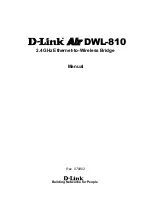
40
If no arguments are given, the current settings for each port are displayed.
Example:
DSL bridge>
ethertype 2 any
5. filter
Syntax:
filter
Description:
This command shows the current contents of the bridge’s filter table. The MAC entries for
each device are shown in turn together with the time that the MAC address was last seen by
the bridge. The command also shows the current filter ageing time, in seconds, and the
number of creation failures since the system was started. Creation failures occur when there
is no room left in the filter table for a new entry.
Example:
DSL bridge>
filter
6. filterage
Syntax:
filterage [<age>]
Description:
This command sets, or displays if no arguments are given, the filter table ageing time. The ageing
time is the time after which MAC addresses are removed from the filter table when there has been
no activity. The time is specified in seconds and may be any integer value in the range 10…100,000
seconds. This value may also be changed through SNMP. Changing the value of filterage has
immediate effect.
Configuration saving saves this information. By default the filter ageing time is set to 300 seconds.
Example:
DSL bridge>
filterage
6. flush
Syntax:
flush [<port>]
Description:
This command allows the MAC entries for a specified port, or all ports, to be removed from the
filter table. The port number for a device may be determined using the
device list
or
status
commands. If the port number is omitted, all entries for all ports are removed from the filter table.
Example:
DSL bridge>
flush
7. portfilter
Syntax:
portfilter [<source port> all|<destination ports>]
Description:
The
portfilter
command allows control over the bridge’s forwarding and broadcasting behavior.
By default, when a multicast or an unknown packet is received on a port (referred to above as the
source port), it will be forwarded to all other bridge ports (referred to above as the destination
ports). Each bridge port may have its behavior modified separately. The first example below
configures the bridge so that packets arriving on port 2 will only be forwarded to ports 3, 4 and 5,
and packets arriving on port 3 will only be forwarded to port 1. All other ports retain their default
behavior. Note that this command does not force packets arriving on the source port to be sent to
all specified destination ports. The bridge retains its learning behavior, so unicast packets, once
their destination is known to the bridge, will still only be sent to one port. Note also that the bridge
itself (for example when attached to the IP router) will always forward to all ports, and will always
be forwarded to by all ports. The default behavior can be restored by calling this command with
the argument “
all
”, as shown in the second example. The ports are specified as integers, as
displayed by the
device list
command. When using this command in the
initbridge
















































